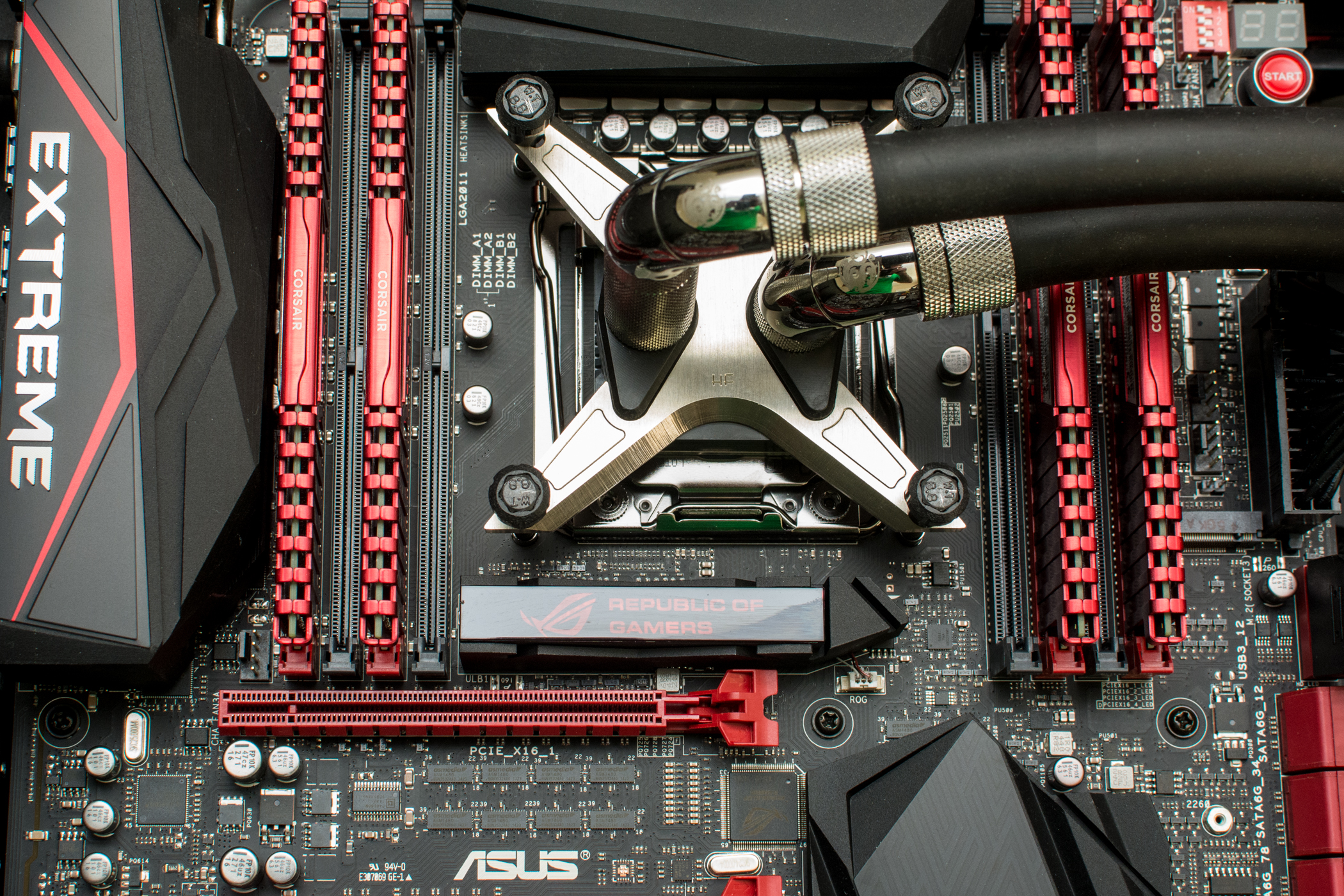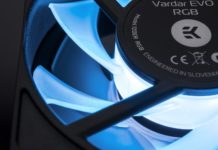The VRM backplate is removed with two screws – the backplate doesn’t cool any active components but merely cools the back of the PCB and provides support for good thermal connectivity on the top VRM cooling.
Because the top VRM heatsink is connected via a heatsink to the IO cover then there are an additional four screws to remove:
The thermal pad on the VRM heatsink shows great pressure and therefore contact. It’s nice to see the chokes are also cooled too.
The IO cover doesn’t have a ton of surface area, but it does have a ton of thermal mass. It’s seriously heavy.
The chokes with their bevelled edge are actually quite sexy. We see 8 VRM IC’s and 8 chokes indicative of 8 phases. Bear in mind that the total number of phases is not everything. Back in X58 days we had boards with 24 phases, but a lower number of higher quality phases can be better than a lot of crappy ones. Asus uses a digitally controlled VRM. Like any modern switching power supply digital control gives faster and more accurate responses than an analog counterpart.
The IC’s in question are International Rectifier 3555, the datasheet that is available doesn’t give too much detail except that the output is rated for “up to” 60A. So with 8 phases theoretically with a 2V output that would give a maximum output power of about 960W. This gives plenty of margin for overclocking. Interestingly the maximum switching frequency is listed as 1MHz but ROG enable 1.2MHz. So it seems like ROG are actually letting us overclock the VRMs too.
The confusing part was the small heatsink in the middle of the board. I thought this might be cooling some additional VRMs, possibly for the PCH or the DRAM. However the heatsink was not thermally coupled to anything:
There are plenty of transistors in the area but nothing actually has a thermal pad on it. The PCH heatsink is nice and independent – it can be removed independently of it’s backplate also:
Asus used to be known on the R3E for their poor thermal connection to the heatsink. Here we see that there is simply TIM with a good spread!
There are no other chips cooled by that IC. The “backplate” for this heatsink also doesn’t cool anything and we assume it’s just there to allow good pressure on the PCH. While it does also cover and provide some impact protection for one IC on the back of the board, there are similar sized IC’s on the back of the board which are not protected.
The IO area has a few more IC’s – mainly ASMEDIA AS1074 USB chips to provide all those USB ports.
The SATA area had a ton of Asmedia chips too which may lead you to think that these are not Intel SATA ports but the ASM1467 is merely a signal buffer with signal reconstruction. Underneath our sexy ER logo is the Asmedia ASM106SE which provides the SATA Express functionality.
You may notice that we’ve seen a lot of Asmedia chips – Asmedia is a subsidary of Asus so this is no accident. Generally I haven’t been a huge fan of Asmedia chips – while benchmarks often show them to be just as fast I feel that the real life experience is actually much worse than the Intel counterparts.
So we spent a ton of time on looking at the board – but what else do you get in the box apart from a motherboard and the OC Panel gadget?
























The Ultra has not dissapeared, see Asus Z10 D8 WS + E5-2699v3, it’s called Workstation.
Agreed, I was referring to systems that could overclock While “real” workstation users will use that workstation board happily my “idea” of ultra enthusiasts consist of people who won’t give up their overclocked performance but still want more cores and are willing to pay for 2P. Those same workstation users who prefer more cores might even be happy with a 4P after all. Since the SR2 there have been no real overclockable 2P chips.
While “real” workstation users will use that workstation board happily my “idea” of ultra enthusiasts consist of people who won’t give up their overclocked performance but still want more cores and are willing to pay for 2P. Those same workstation users who prefer more cores might even be happy with a 4P after all. Since the SR2 there have been no real overclockable 2P chips.
[…] Asus Republic of Gamers Rampage V Extreme X99 Motherboard Review for Overclockers! […]
Nice Review! Helped me a lot!
Can you tell me the name of the Waterblock in the top picture please? It looks so sick!
MIPS IceForce HF – MIPS closed down and I think AquaTuning bought all the remaining stock – so that might be your best for these if any remain!
Thank you very much!
[…] Asus Republic of Gamers Rampage V Extreme X99 Motherboard Review for Overclockers! […]
I think this board is too much oriented to the LN2 and TEC peoples. Of course we live under their umbrella so if ASUS covers those peoples, we are covered too. But sadly, most of us mortals won’t even use these hardware level (and few software level) features for WC builds, so don’t you think there should be lower-dog of ROG (probably R5 Formula) for X99? Or does Deluxe suffices?
I have to admit I’d rather see a Gene matx version before a formula. Yes for some the deluxe suffices for that role though
[…] Asus Republic of Gamers Rampage V Extreme X99 Motherboard Review for Overclockers! […]
Comments are closed.